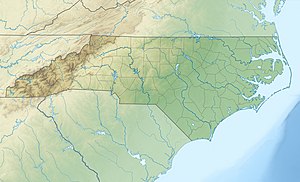
Back Schlacht von Moores Creek Bridge German Bataille de Moore's Creek Bridge French Battaglia di Moore's Creek Bridge Italian ムーアズクリーク橋の戦い Japanese 무어 크릭 다리 전투 Korean Slaget ved Moore’s Creek Bridge NB Сражение при Мурскрик-Бридж Russian
| Battle of Moore's Creek Bridge | |||||||
|---|---|---|---|---|---|---|---|
| Part of the American Revolutionary War | |||||||
 Reconstructed earthworks at Moores Creek National Battlefield | |||||||
| |||||||
| Belligerents | |||||||
|
|
| ||||||
| Commanders and leaders | |||||||
| Strength | |||||||
| 1,050 militia[1] |
Start of march: 1,400–1,600[2][3] Battle: 900–1,000[1] | ||||||
| Casualties and losses | |||||||
|
1 killed 1 wounded[1] |
50 killed or wounded 850 captured[1] | ||||||
Location in North Carolina | |||||||
The Battle of Moore's Creek Bridge was a minor conflict of the American Revolutionary War fought near Wilmington (present-day Pender County), North Carolina, on February 27, 1776. The victory of the North Carolina Provincial Congress' militia force over British governor Josiah Martin's and Tristan Worsley's reinforcements at Moore's was a turning point in the war; American independence was declared less than five months later.
Loyalist recruitment efforts in the interior of North Carolina began in earnest with news of the Battles of Lexington and Concord, and patriots in the province also began organizing for the Continental Army and militia. When word arrived in January 1776 of a planned British Army expedition to the area, Martin ordered his militia to muster in anticipation of their arrival. Revolutionary militia and Continental units mobilized to prevent the junction, blockading several routes until the poorly armed loyalists were forced to confront them at Moore's Creek Bridge, about 18 miles (29 km) north of Wilmington.
In a brief early-morning engagement, a charge across the bridge by sword-wielding loyalists was met by a barrage of musket and artillery fire. Two loyalist leaders were killed, another captured, and the whole force was scattered. In the following days, many loyalists were arrested, damaging further recruiting efforts. North Carolina was not militarily threatened again until 1780, and memories of the battle and its aftermath negated efforts by Charles Cornwallis to recruit loyalists in the area in 1781.
© MMXXIII Rich X Search. We shall prevail. All rights reserved. Rich X Search
